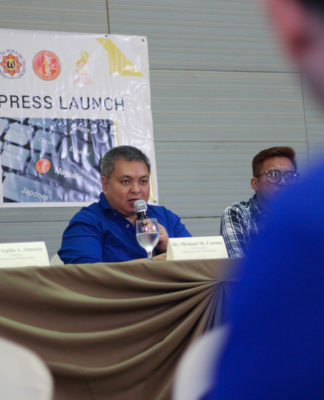DR. CENON Alfonso, UST Hospital president and chief executive officer, has become the latest official to quit following the Dominican leadership’s decision to halt the construction of a 19-story hospital tower that would have required the University’s medical institution to go into more profitable businesses and take a P3 billion bank loan.
“I was asked to resign by the new rector in line with the reorganization of the hospital,” Alfonso told the Varsitarian following a meeting with Acting Rector Fr. Rolando V. De La Rosa, O.P. last Sept. 17.
Alfonso had opted to wait for clearer signals from higher-ups before finally quitting even with the earlier resignations of three top University officials who were also members of the hospital’s board of trustees — Fr. Edmund Nantes, O.P., prior provincial of the Philippine Dominican Province and UST vice chancellor; UST Rector Fr. Ernesto Arceo, O.P., the hospital chairman; and Vice Rector Juan Ponce, O.P.
Three days before his resignation, Alfonso met separately with hospital employees and doctors to say that operations would go on as usual. But he was quick to add that the hospital administration would have to quit if told to do so by the board.
The Master of the Order of Preachers, Fr. Carlos Alfonso Azpiroz Costa, O.P., has ordered the dissolution of the hospital corporation that had separated
It was unlikely the loan repayment terms would be met, the Master told the meeting .
Under the 10-year syndicated term loan agreement, state-owned Development Bank of the Philippines (DBP) was to lend P1.5 billion. Another government bank, the Land Bank of the Philippines, was to lend P1 billion. The rest was to be shouldered by Philtrust Bank (P300 million) and DBP Trust Services (P200 million).
Two days after his resignation, the hospital president e-mailed a long letter to medicine alumni answering the Master’s declaration, saying the “transgression” was “unintended.”
The hospital spinoff had saved it from years of losses and mounting debt, Alfonso said.
The Vatican and the Master wanted to clear expenditures beyond $100,000 (P5 million) based on Church laws, he said.
“Despite the lack of canonical approval of the Master and of the Holy See, it is an undeniable fact that the juridical separation of the Hospital from the University was the important key of the turnaround of the Hospital from its certain collapse and closure. If it were not done, the Hospital would have been either closed down or have been managed by another group that would have closed down its charity division,” Alfonso said.
“As we humbly leave our responsibilities to the next administrators after having been requested to by the Master of the Order, we make this appeal to the Master not to revert back the organization to where it came from but rather continue the projects as planned that are most vital for the Hospital’s survival in the next 10 years. We likewise appeal that a canonical remedy called sanatio be made rather than a complete reversal which may wipe out the remaining advantage that have been painstakingly won over during the last three years,” he added. (Sanatio is a canonical process of healing or beneficial restoration- Ed.)
Alfonso said financial projections indicated that the expansion plan was viable, citing the newly opened Benavides Cancer Institute, which he said was poised to achieve its targets a year in advance, because of overwhelming patronage.
“Now, what is the risk of the P3 billion investment? Is this unreasonable? For someone who is not familiar with hospital management and affairs, yes. For someone who has not even made a single large investment elsewhere, yes,” he said.
Moreover, the “obscure” Canon Law provisions were not applied in other UST transactions, Alfonso claimed.
“Following the same Canon, all other corporations that have assumed a separate juridical entity from UST like the Benavides Foundation, Inc., the St. Thomas Charity Foundation, Inc., the UST Review Center, and the corporation that runs the Isabel Building are likewise ‘unlawful,’” he said.
Under Alfonso, the hospital swung to profit — P36 million in 2005 from a loss of P57 million in 2004 — and revenues went up to P1.3 billion. Occupancy has also been the highest in five years.
The plan eventually was to increase the number of beds to 1,200 from 800 to maintain the 460-bed charity ward — the largest in any private hospital in the Philippines. There are a mere 352 paying beds in the hospital, not enough the subsidize the charity ward, officials had said.
The expansion however, meant that the hospital must go into profit-oriented activities such as medical tourism and cosmetic surgery, including services like bariatric surgery, the drastic procedure for morbidly obese patients. UST Hospital was among six hospitals given government accreditation to treat foreign patients under the medical tourism program, and had planned to open an “international wing” with up to 100 beds by next year.
But many were angered by the decision to begin charging medical students training at the hospital as well as a re-accreditation of doctors holding clinics at the Medical Arts Bldg.
The Sept. 11 circular of UST Secretary General Fr. Isidro Abaño, O.P. indicated that the plans will have to be reviewed, confirming reports that the hospital projects had caused concern all the way to the Dominican headquarters in Rome.
“The redevelopment project for the UST Hospital will remain an important priority of UST. Further studies will need to be undertaken in order to find the most effective redevelopment plan,” the circular stated.
The UST Hospital labor union did not hide its disappointment over the resignations, holding a rally last Sept. 12. Union members held placards calling for a “fair trial” for the three priests. “Father Master-General, we hope that the information you’ve got regarding the three priests are true,” one placard read.
















